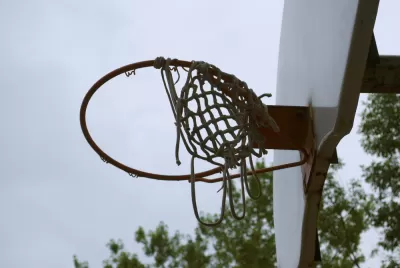Noise and drug dealers are two reasons to remove city-owned basketball hoops every day. Or you could give the public resources for fun and exercise in place, which is what Toronto decided to do this week.

"It took one viral video — boys throwing a basketball at an empty backboard in broad daylight — to halt a long-standing city practice," reports Jennifer Pagliaro.
The city spent about a decade removing rims from city-owned basketball courts until the video woke the public up to the punitive and counter-productive nature of the practice.
The practice began in 2008 as a response to noise complaints from residents living near city basketball courts. City spokesperson Brad Ross said in a statement that noise complaints will be addressed on a case-by-case basis in the future.
“Having a big city is a balancing act all the time,” Mayor John Tory told reporters Thursday morning. “I think that what happened, as often happens in cases like this, is that balance was lost, in that I can understand 10 o’clock at night people maybe — or 11 o’clock at night — saying that they’re concerned about noise. But at 6 o’clock in the evening or even 9 o’clock in the evening at this time of year we should be doing everything we can to get as man kids as possible to be playing basketball in our public parks.”
Tory said residents can’t assume they will live free of noise in a city like Toronto and said there is a need to have “healthy, positive” activities for youth.
Focusing on noise might only tell part of the story, however. Pagliaro also notes that rims were originally removed as a deterrent against "drug dealers."
FULL STORY: After viral video, city halts long-standing practice of taking basketball rims down at some public courts

Alabama: Trump Terminates Settlements for Black Communities Harmed By Raw Sewage
Trump deemed the landmark civil rights agreement “illegal DEI and environmental justice policy.”

Planetizen Federal Action Tracker
A weekly monitor of how Trump’s orders and actions are impacting planners and planning in America.

The 120 Year Old Tiny Home Villages That Sheltered San Francisco’s Earthquake Refugees
More than a century ago, San Francisco mobilized to house thousands of residents displaced by the 1906 earthquake. Could their strategy offer a model for the present?

In Both Crashes and Crime, Public Transportation is Far Safer than Driving
Contrary to popular assumptions, public transportation has far lower crash and crime rates than automobile travel. For safer communities, improve and encourage transit travel.

Report: Zoning Reforms Should Complement Nashville’s Ambitious Transit Plan
Without reform, restrictive zoning codes will limit the impact of the city’s planned transit expansion and could exclude some of the residents who depend on transit the most.

Judge Orders Release of Frozen IRA, IIJA Funding
The decision is a victory for environmental groups who charged that freezing funds for critical infrastructure and disaster response programs caused “real and irreparable harm” to communities.
Urban Design for Planners 1: Software Tools
This six-course series explores essential urban design concepts using open source software and equips planners with the tools they need to participate fully in the urban design process.
Planning for Universal Design
Learn the tools for implementing Universal Design in planning regulations.
Clanton & Associates, Inc.
Jessamine County Fiscal Court
Institute for Housing and Urban Development Studies (IHS)
City of Grandview
Harvard GSD Executive Education
Toledo-Lucas County Plan Commissions
Salt Lake City
NYU Wagner Graduate School of Public Service



























